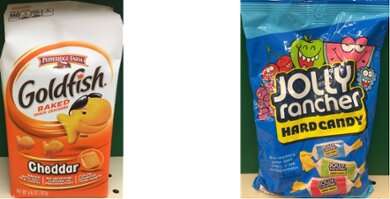An example of two snacks that the test subjects had to choose from in Judith Schomaker’s research. Credit: Judith Schomaker
Mountains of pepernoten, shelves full of chocolate letters and adverts showing the perfect Christmas table. With the holidays approaching, supermarkets are trying to entice us to buy all sorts of treats. Cognitive neuropsychologist Judith Schomaker researches how by directing consumers' attention, you can influence their behavior.
Imagine you are given the choice of a bag of cookies and a piece of cake. You probably have a preference for one of the two. But if your eyes are now drawn to the other one, would you choose it after all? This is exactly what Judith Schomaker researches. "We know from the literature that if you get people to look at something for longer, they are more likely to choose it. Even if it isn't their preference. The link between attention and decision-making is very strong therefore, and to a certain extent causal even."
Directing the attention influences your choice
In a lab, Schomaker served up two photos of snacks at a time, and asked people to say which one they preferred. She began with a baseline measurement to see where the test subjects' preferences lay. Then she again showed them two photos of snacks, but just before doing so, she very briefly showed an arrow pointing to the left, right or both sides. Schomaker: "We didn't say anything about the arrow, but gave the test subjects the same task: choose your favorite." The result? The test subjects' eyes were drawn to the product that the arrow was pointing to and focused on this product for longer. And the test subjects more frequently chose the snack that the arrow was pointing to. "Even if the other snack was the one that they preferred," says Schomaker. In other words: you can direct people's attention and thus influence their decisions.
Can you also get people to make healthy choices by directing their attention? Schomaker will soon be repeating her experiment, but then with a choice between a snack and something healthy. Credit: Judith Schomaker
Marketing trick
But we knew that already, didn't we? "The principle has indeed been used for years in marketing," says Schomaker. "Manufacturers try to attract the consumer's attention with packaging, a special display in the shop or even arrows on the floor. It's just that we have now confirmed in the lab that it works." There is a proviso, says Schomaker: people's choices can principally be influenced if they are choosing between two equal products. "If someone likes sweet things and has to choose between crisps or wine gums, it won't work." And it mainly works if you have to make a quick choice, for instance with those infamous checkout purchases.
Take more time to consider your purchases
Of course, unlike Schomakers' test subjects, we are not forced to choose between two products in the supermarket. However, she does have a tip from her research to arm us against the pepernoten, marzipan and other treats that shopkeepers like to draw our attention to. "Simply take more time to consider your purchase. The more time you take to think, the less the effect of your attention being directed to a specific product." Do you apply this technique when you are out shopping? She laughs: "Yes, maybe too much even! You obviously have to strike a balance between the amount of time you spend considering a purchase and what you are going to purchase. It makes sense to take plenty of time if you're buying a car but it doesn't with a carton of milk." Perhaps giving in to the temptation of that bag of pepernoten every now and then isn't such a bad thing after all.
Provided by Leiden University























